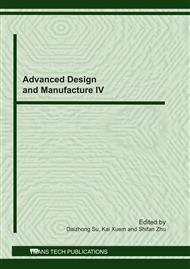[1]
X. Ligong, Z. Zude, L. Quan, Multi-agent Architecture for Collaborative CAD System, Computer Science and Information Technology, International Conference on, pp.7-11, 2008 International Conference on Computer Science and Information Technology, (2008)
DOI: 10.1109/iccsit.2008.43
Google Scholar
[2]
N. Yabuki, J. Kotani, T. Shitani, A Cooperative Design Environment Using Multi-Agents and Virtual Reality, Cooperative Design, Visualization, and Engineering, Ed. Luo, Yuhua, LNCS, vol. 3190, pp.96-103, Springer Berlin / Heidelberg, (2004)
DOI: 10.1007/978-3-540-30103-5_11
Google Scholar
[3]
T. Shitani, N. Yabuki, A Concrete Bridge Design System Using Multi-Agents, Soft Computing as Transdisciplinary Science and Technology, ed. A. Abraham et al., Advances in Intelligent and Soft Computing, vol. 29, pp.695-704, Springer Berlin / Heidelberg, (2005)
DOI: 10.1007/3-540-32391-0_74
Google Scholar
[4]
S. Baumgart, B. Toledo, K. Spors, M. Schimmler,: PLUG: An Agent Based Prototype Validation of CAD-Constructions, in The 2006 International Conference on Information and Knowledge Engineering, (2006)
Google Scholar
[5]
L. Kotulski, B. Strug, Distributed Adaptive Design with Hierarchical Autonomous Graph Transformation Systems. ICCS 2007, LNCS 4488, pp.880-887, Beijing(China), (2007)
DOI: 10.1007/978-3-540-72586-2_123
Google Scholar
[6]
L. Kotulski, A. Sędziwy, On the Effective Distribution and Maintenance of Knowledge Represented by Complementary Graphs, ed. Piotr Jedrzejowicz et al., KES-AMSTA 2010, LNCS, vol. 6070, pp.381-390, Springer, (2010)
Google Scholar
[7]
L. Kotulski, GRADIS – Multiagent Environment Supporting Distributed Graph Transformations. M. Bubak et all (Eds.): ICCS 2008, Part III, LNCS 51031, pp.644-653, (2008)
DOI: 10.1007/978-3-540-69389-5_72
Google Scholar
[8]
L. Kotulski, A. Sędziwy, Agent framework for decomposing a graph into the equally sized subgraphs, in Proceedings Of The International Conference On Foundations Of Computer Science, FCS 2008, Las Vegas, NV, (2008)
Google Scholar
[9]
L. Kotulski, A. Sędziwy, GRADIS - The Multiagent Environment Supported By Graph Transformations. Simulation Modelling Practice and Theory, Vol.18, Issue 10, pp.1515-1525, November 2010.
DOI: 10.1016/j.simpat.2010.05.013
Google Scholar
[10]
FIPA Specifications: http://www.fipa.org/specifications/index.html
Google Scholar


